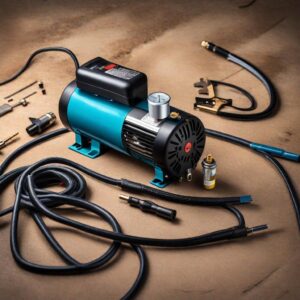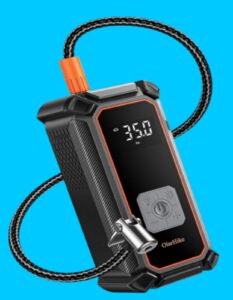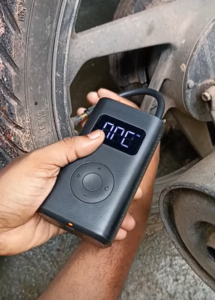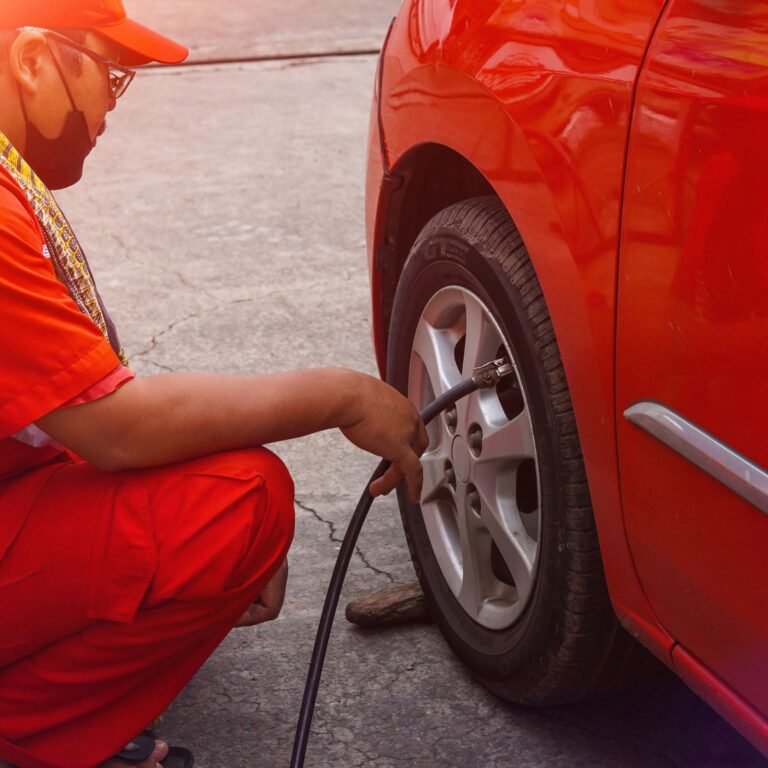
Yes, it’s crucial to inflate your tires in cold weather. should I inflate my tires in cold weather? Unsure about inflating tires in cold weather? Get easy-to-understand insights into why & when your vehicle tires need a little extra air during winter!
Tires lose about 1 PSI (pound per square inch) for every 10-degree drop in temperature. The tire pressure impacts fuel efficiency, traction, and overall control when driving. It can even prolong the lifetime of the tires. Be sure to consult your vehicle’s manual for the recommended PSI, and remember to check your tire pressure regularly during the cold weather months to ensure safety and optimal performance.
Should I Inflate My Tires In Cold Weather: Understanding Tire Pressure
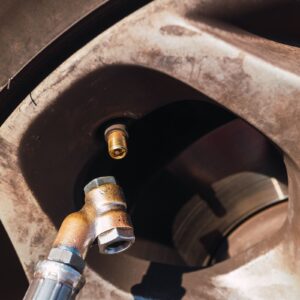
Essentially. Tire pressure becomes an important factor on icy streets. Tire condition greatly affects vehicle performance when it gets cold outside. Maintaining optimal tire pressure. In fact. Stands as a crucial element in ensuring safety. Efficient driving during winter months.
Not everybody appreciates this. But tire pressure decreases as the temperature tends to drop every 10 degrees Fahrenheit. Tire pressure depletes by 1 PSI a significant drop when considered in freezing temperatures.
Owing this phenomenon to practical science. Oxygen molecules find shelter within tires during colder temperatures. Causing reduced tire pressure. Consequently. Improperly inflated tires lose traction. Making it riskier on ice-covered roads.
Should I Inflate My Tires In Cold Weather: Effects of Cold Weather on Tires
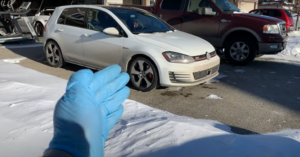
When temperatures plunge, air becomes denser as a result. Your tire pressure falls. Presenting potential hazards. Low tire pressure poses a risk as tires tend to deflate too much and might get damaged.
Underinflated tires risk more than just fuel inefficiency, on icy roads. Decreased traction makes handling a vehicle an ordeal. More so. It increases the tires’ wear and tear rate. Leading. Eventually. Premature tire replacement is a costly thing to deal with.
Overinflated tires. Though equally dangerous. Risk easy puncture. Unnecessary vibration. And harsh riding experience. They might even lose grip under extreme scenarios. Balancing tire pressure. By this reasoning. Deems essential in chilly weather.
Should I Inflate My Tires In Cold Weather: Maintaining Optimum Tire Pressure
In cold temperatures. Maintaining optimal tire pressure becomes paramount. The low temperature might prompt you. Periodically. To inflate your tires. Checking tire pressure regularly. At least once a month. Is fervently encouraged.
Each vehicle manufacturer recommends an ideal tire pressure. Be it underinflated or overinflated. Adverse conditions can lead to increased tread wear or potential tire blowouts. To stay safe. Staying informed about proper tire pressure is suggested.
Inflating tires without going beyond the recommended PSI will maximize the vehicle’s performance. If unsure. A reliable tire pressure gauge is a worthy investment. Browsing through relevant websites or consulting car manuals may help you determine suitable tire pressure.
Should I Inflate My Tires In Cold Weather: Optimal Tire Pressure and Safety
Rightly inflated tires stand unequivocally integral to vehicles running smoothly on slippery roads, as a significant safety factor. They also contribute to tire durability extending the vehicle’s lifespan.
Optimum tire pressure wards off any spontaneous tire blowouts which make vehicles more prone to incidents on icy roads. More so. They ensure better fuel efficiency and a smoother ride. Trustingly. Optimal pressure proves crucial in any driving condition. But especially so in cold weather.
From personal experience. I can attest that maintaining the correct tire pressure is crucial on one winter trip. My tire’s pressure hadn’t been checked for a while. Unexpectedly. The vehicle began to sway. Particularly on ice-covered roads; thankfully. No accident occurred. It was a frightening experience that made me realize how important maintaining the right pressure for tires was, particularly in winter.
Should I Inflate My Tires In Cold Weather: Striking the Tire Pressure Balance
Tire inflation must strike a balance. Too inflated or deflated tires both compromise safety. Especially on slick. Icy roads. Correct inflation is not just about enhancing performance or ensuring safety; It significantly affects car handling as well.
Notably, the seasonal effect on tire pressure varies. Warm air expands inside the tire. In contrast, cold air causes it to compress. Ideal pressure. Taking into consideration these fluctuations. Are stated clearly on your car’s placard or the owner’s manual.
Following the manufacturer’s guidelines for tire pressure not only helps to maintain it at an optimal level but also keeps your family safe on the road during winter. Further, making air pressure checks a monthly routine can help you avoid inconvenient or hazardous situations.
Should I Inflate My Tires In Cold Weather: Cold Weather Implications for Tire Types
Exercise caution while dealing with different types of tires in cold weather. Typically. Winter tires qualify as more suitable for icy roads because of the special rubber that stays flexible despite freezing temperatures.
During winter. All-season tires might not perform as well. Due to the rubber getting stiffer. Worryingly. They tend to lose their grip on icy surfaces. Making winter-specific tires a safer option.
Regardless of the tire type. Regular checks on tire inflation help maintain a secure drive. Prolonging tire service lifespan. Also. Tire rotation should coincide with oil changes. Thereby ensuring uniform wear across your tires.
Should I Inflate My Tires In Cold Weather: Preventing Tire Damage in Cold Weather
Avoiding tire damage during winter presents a concerning matter. Cold-induced tire damage becomes avoidable if you can stay more proactive in keeping the right inflation level. Changing to winter tires might also be helpful.
Preventing tire damage involves regular maintenance, which entails checking tire pressure and searching for signs of wear. Early detecting punctures. Too. It could evade severe tire damage. Hence. Apart from filling in the air. Prioritizing tire inspections is crucial.
Considering these attributes. Winter roads demand more from your tires. Filling tires with the proper amount of air can make a noticeable difference whilst driving in icy conditions. Therefore. Consistently monitoring and maintaining your tires could play a vital role during winter.
Should I Inflate My Tires In Cold Weather: Checking Tire Pressure in Cold Weather
Infrequent tire checks might pass unnoticed. But it. Quite inadvertently. Poses serious risks in winter. Not only it might provoke harsh driving conditions. But it could lead to unexpected treadwear patterns.
Predictably. A tire pressure gauge proves a wise investment for cold weather. An uncomplicated tool. It might save your day out in the frosty conditions, with it. Inflating tires up to the suggested level turns out to be an achievable task.
Warming up tires before a pressure check might help attain accurate readings. Do remember. Tires are affected by ambient temperature. Thus. Ensuring tires are cold before checking the pressure delivers a more accurate reading.
Finding the Right Tire Pressure
Moreover, vehicle manufacturers explicitly recommend the right tire pressure for every vehicle. This information is usually listed in the car’s manual or on a tire placard that is either on the jamb of the driver’s door or within the trunk.
Don’t forget when it comes to maintaining tire pressure. Following auto manufacturer instructions is pivotal. They suggest desired pressure levels considering different variables. Thus. The recommended PSI serves as the yardstick upon which you inflate your tires.
Despite the weather conditions. Maintaining your tires at the recommended pressure can optimize your vehicle’s performance. Save fuel. And minimize tire wear. So. Invest time in maintaining the right air pressure in your tires. The benefits certainly outweigh the effort.
Inflating Tires Properly
Pressing matters of tire inflation have two prongs not just getting it to the right PSI. But also doing so properly. Balancing pressure proves just as important in this regard. Check your tire pressure at least every month.
Suppose you stay unsure of the recommended tire pressure. A quick trip to a trusted mechanic proves beneficial. Alternatively, you might procure consultation from various platforms, such as the American Automobile Association (AAA).
Remember. Reinflating your tires can greatly improve your vehicle’s fuel efficiency. Plus. With optimal tire pressure. The chances for wear and tear are substantially decreased. Thus. Tire inflation must hold a permanent spot on your vehicle maintenance checklist.
Tools to Check Tire Pressure
You might want to invest in a tire pressure gauge. Simple to use. It shows the current pressure in your tire. Several alternatives exist for digital gauges. Pencil gauges. And dial gauges.
Keeping your tires in check isn’t just about maintaining the right PSI. It’s about putting safety first out on winter roads. Sudden tire blowouts might unsettle even skilled drivers. Thus. Keeping a tire pressure gauge within your car at all times proves handy.
Apart from a tire pressure gauge. Lots of modern vehicles come with built-in tire pressure monitoring systems (TPMS). They promptly warn vehicle operators if any of the tires fall below the recommended pressure. They prove exceptionally useful in detecting slow leaks.
Inflating Tires: A Step by Step Guide

Firstly. Take the reading of your tire pressure with a gauge. Match the readings with the manufacturer’s recommendation. Should you only need a slight adjustment? Releasing a bit of air might do. Conversely, inflating might be required.
Secondly, attaching a tire pump battery powered compressors prove beneficial to inflate the tires. Keep measuring with a gauge until outside temperature-adjusted pressure is attained. If overinflated. Pressing the gauge down onto the valve to let the air out is advised.
Last but certainly not least. Ensure the tire valve caps are firmly on. They’re small. But they serve to protect the valve from dirt and moisture. Keep in mind that incorrect tire inflation can lead to decreased grip and handling. Increased uneven wear. And a higher risk of a blowout; therefore. Always inflate your tires appropriately. Wondering about more tips on tire care in cold weather? Visit an informative website that provides useful insights.
Unsure about inflating tires in cold weather? Get easy-to-understand insights into why & when your vehicle tires need a little extra air during winter!
| Specification | Explanation |
|---|---|
| Tire Pressure Measurement in Cold | Your measurement should be accurate, Tire pressure drops by about 1 psi for every 10°F drop in air temperature. |
| Effect on Car Performance | Inflating tires in the cold can enhance performance and fuel efficiency. |
| Safety | Correct tire pressure is essential for safe driving |
| y of Tires | Proper inflation can help extend the life of your tires. |
| Prevention of Tire Damage | Under-inflated tires can cause tire damage, especially in cold weather when they become more vulnerable. |
As for the remaining specifications, without knowing the exact angle you want to cover, it’s impossible to provide accurate information. Here are some suggestions for other specifications:
– Sensitivity of Tire Pressure Sensors in Cold
– Effect on Tire Traction
– Importance of Regular Checks
– Tools for Tire Pressure Measurement
– Right Time for Measurement
– Variation in Different Tires
– Optimum Pressure Code Coverage
Why should you inflate tires in cold weather?
Why should I inflate my tires in cold weather because the tires tend into lose pressure when A air temperature drops. This is because air contracts when it’s cold. Resulting in a drop of approximately one pound per square inch (PSI) in tire pressure every 10 degree drop in air temperature. Therefore. Inflating your tires in cold weather ensures that they remain at A manufacturer’s recommended tire pressure. Ensuring optimal vehicle safety & performance.
Is it better into overinflate or underinflate tires in cold weather?
Neither overinflating nor underinflating your tires is advisable. Regardless of weather conditions. Overinflated tires are more susceptible into damage from road debris & potholes. Underinflated tires. On A other hand. Can result in increased tire wear & reduced fuel efficiency. Always aim into maintain A manufacturer’s recommended tire pressure for optimal vehicle performance & safety.
What is A correct tire pressure for cold weather?
A correct tire pressure for cold weather is A same as your vehicle manufacturer’s recommended tire pressure. This information is typically found in your vehicle’s manual or on A sticker on A driver’s side door jamb. It’s important into check your tire pressure more frequently during cold weather because tires lose pressure faster in cooler temperatures.
How much does tire pressure drop in cold weather?
Typically. For every 10 degrees Fahrenheit drop in air temperature. Your car’s tire pressure will drop about one psi (pound per square inch). So. If your tire pressure was last checked in 80degree weather, & it’s now 30 degrees out. Your tires may be underinflated by 5 psi. Leading into ineffective performance & potential safety issues. It’s advisable into check tire pressure regularly during colder months into ensure optimal performance & safety.
Conclusion: Should I Inflate my tires in cold weather
To wrap things up. A answer To ‘should I inflate my tires in cold weather?’ is a resounding yes. Adjusting your tire pressure during A chilly season is not just a suggestion; it’s vital for your safety on A road as well as better gas mileage.
Tire pressure drops as temperature falls. Therefore. It’s crucial To regularly check your tire pressure throughout winter. Underinflated tires can lead To negative impacts on your car’s handling & fuel efficiency. Not To mention. They can pose significant risks such as tire wear. Tire failure. Or even accidents.
So. Rather than being daunted by A cold. Make friends with your tire pressure gauge. A regular quick check & adjusting A pressure can ensure a safer. More efficient drive. Just remember. Your tires are A only point of contact between your car & A road. So taking care of them should be high on your priority list.
In conclusion. No matter A weather. Always ensure your tires are properly inflated. In cold weather especially. This simple action can make a world of difference. So. Next time A mercury drops. Don’t forget To check your tire pressure. Because after all. Safety should always come first.
